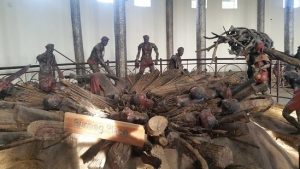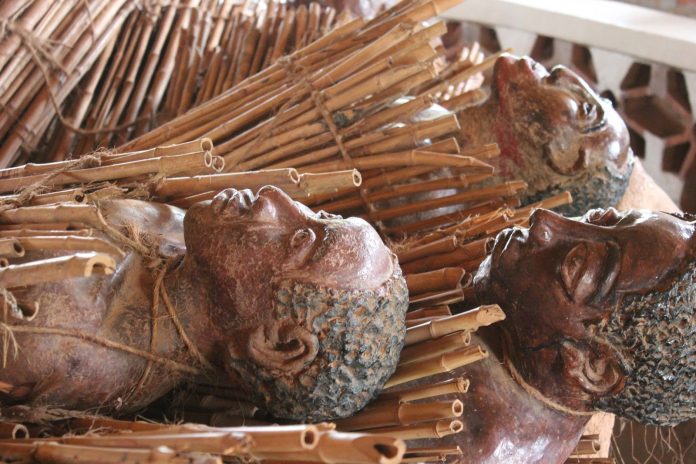The appearance of the first none black persons on the fertile land of Uganda was in 1843, the Arabs who moved from the East African coast were received at courtyards of Wamala palace by Ssekabaka Sunna ll in the Buganda kingdom. The Arabs introduced Islamic and foreign religions that emerged on the land and that converted king Sunna II to Islam.
In 1861, European explore John Hanning Speke through the waves of Uganda was also received in the East African interior, and his reach to the Buganda Kingdom was received by Ssekabaka Mutesa I king of Buganda. With the guidance of Henry Merton Stanley King Mutesa, I wrote a letter to Queen Victoria of England inviting missionaries to Buganda.
Ssekabaka Mutesa’s letter to the Queen was written on 14th April 1875 and was published in the Daily Telegraph on November 15th, 1875.
In 1877, the first group of missionaries was welcomed to Buganda i.e. Church Missionary Society (CMS) of Anglican Communion from England. Then by 1879, the White Fathers from France followed the Roman Catholic Church.
The coming of the two religions both settled on the hills of Rubaga hill for the White Fathers of the Catholic Church and Namirembe hill for Anglican Church Missionary Society and clashed to win converts in their denominations.
The two religions got so much involved in the political arrangements of the Buganda kingdom and later had to extend their activities beyond the boundaries of Buganda.
The influence of explorers and missionaries and their colonial rule initiated the integration of monarchies to form Uganda.
In the 1880s, religious wars silently became famous as the three religions of Anglican, Catholic, and infamous Islam wriggled to influence the political affairs of the country. In the process of religious wars, a number of converts lost their lives.
In 1884, Ssekabaka Mutesa I died and his son Ssekabaka Mwanga II succeeded him as 31st king of Buganda. King Mutesa I discerned how to drama about with religions but not converting to anyone, but greatly relayed on the Anglican communion to near his monarch with the England government.
By 1884, Ssekabka Mwanga II succeeded as the 31st king of the Buganda Kingdom. Devout calamity started with king Mwanga II who never believed in any of the religions, yet a number of his pageboys were devout among the religions.
The line of martyr execution
King Mwanga II wished that all his pageboys would denounce their converted religions which never happened, the King was accused of sodomizing them. This initiated the route of the martyrs which started just a year after Mwanga became a king.
On 25th November, Joseph Mukasa Balikuddembe, the king’s majordomo, was among the key leaders of Christian believers from the catholic community who pioneered the martyr execution at Nakivubo Kampala city center. Balikuddembe accused Kabaka Mwanga of ordering the killing of an Anglican Bishop James Hannington, the king had Bishop Hannington was coming to Buganda through the eastern and the king believed anyone person coming from the east was a threat to his throne. Because of this accusation, Balikuddembe was beheaded and burnt into ashes.

In 1886, the King ordered his royal man Mukajjanga the chief executioner to kill every pageboy who couldn’t denounce Christianity. The reasons were that instead of these people serving the king in the palace were busy with religious activities. The execution of believers took place at Namugongo the designated execution for the Buganda kingdom during Mwanga’s reign.
Charles Lwanga suspected danger happening to Uganda’s Christian community on 25th May 1886, he secretly baptized four catechisms at Munyonyo including Kizito, Gyavira Musoke Mayanja, Mbaga Tuzinde, and Mugaga Lubowa.
That very morning, Ssekabaka Mwanga summoned all his court, he separated Christians from the rest, and the King said those who don’t pray to stand by me and those who pray to stand over there. He continued to ask those who pray whether they were Christians and if they were intending to remain Christians. Some coverts insisted on and said ‘yes,’ with strength and courage King Mwanga condemned them to death.
All the devout believers were imprisoned for a short while then bound to each other on twisted lops escorted by ruthless soldiers and started their journey to Namugongo the execution site.
The first martyr execution started earlier with Balikuddembe at Nakivubo, But Mwanga launched execution at Munyonyo. The Christian converts started their pilgrim journey to Namugongo the execution site.
At Munyonyo three were killed including Denies Ssebugwawo, Andrew Kagwa, and Pantiano Ngondwe.
Morning of 27th May 1886 at mango Athanasius Bazzekuketta volunteered to be executed at the foothills of Mengo palace’s current place Kisenyi. Along the trek, on the same day at Old Kampala Mathias Mulumba, he refused to continue walking further and demanded his execution here. The hands were cut off first, the skin was peeled off from his back and legs were cut off, he was left with bleeding open vessels, and later after three days, Mulumba died.
Believers tied on neck and feet to another by cords and stocks moved over 10 miles to Namugongo. Reaching Namugongo, the martyrs were confined for a week before their execution, by that time executioners were preparing and collecting enough firewood and rids for burn victims.
On 3rd June 1886, the official executions took place, and the martyrs were tied in rids. Ssenkole the guardian of the sacred fused and singled out Charles Lwanga to be the first victim of the holocaust. Ssenkole was not allowed to be present at the actual scene of the large execution but in ritual practices had to select one of the victims and burn him apart from the others.
At Namugongo the official execution place, 22 young men were set on fire, it’s told these men kept praising and praying while burning in flames. Before, the martyrs were made to arrange their own firewoods and rid, and executioners tied one by one in try rids where they burned slowly to ashes.
In total 45 younger believers we killed for the sake of their faith, 23 of them belonged to the Anglicans and 22 were catholic.
Declaration of the martyrs
At Namugongo where Charles Lwanga was executed currently exits the iconic Basilica the Martyrs Shrine. The Arch Bishop Emmanuel Nsubuga fronted the construction of the Martyrs’ shrine in preparation for Pope John Paul VI’s visit in 1969 who launched the construction of the Shrine.
On October 18th, 1964, Pope Paul VI solemnly announced the catholic martyrs as saints in St. Peters’ Basilica Vatican Rome.
The declaration made these sacred places special for believers. Every 3rd of June multitude of believers all over the world emerge to celebrate the anniversary of the Holy Martyrs day at Namugongo Uganda.
Today the martyr’s catholic infrastructures were highly boosted with the construction of gluttons, renovation of the basilica, and the construction of the pavilion which facilitated a bigger number of pilgrims who always storm the shrine in millions.
As well the Anglican martyrs are celebrated, there is a martyr’s museum constructed at Nakiyanja just approximately 2 miles from the catholic shrine. The Museum display a perfect process of execution and tour entry is a fee at both sites.
The Martyr’s pilgrim trail starts right from Munyonyo, to St. Balikkudembe Owino market, continues Matia Mulumba at Old Kampala, and everything is crowned at Namugongo Martyrs shrine and Martyrs Museum.








